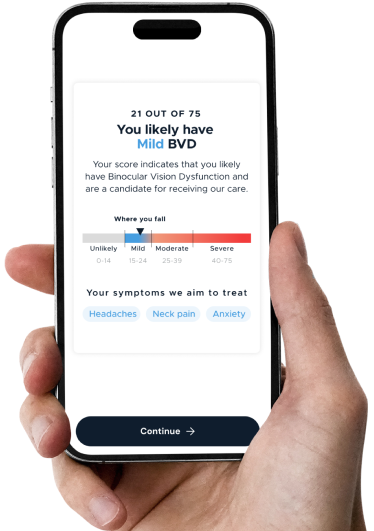Having 20/20 vision means clear distance sight but doesn’t ensure comfortable visual processing. Subtle eye misalignments, like Vertical Heterophoria, can cause eye strain, headaches, dizziness, and trouble concentrating during reading—even with perfect visual acuity.
When 20/20 Vision Isn’t Enough
- “I’ve just had an eye exam, but I still can’t read.”
- “I’ve had eye exams, and they’ve told me everything’s OK.”
- “There’s nothing wrong with my eyes.”

Do any of these statements sound familiar? While most people would say perfect vision entails having 20/20 acuity, for many people that’s not necessarily enough. If your brain isn’t processing the visual signals around you correctly, perfect eyesight isn’t going to do you much good. And while yearly eye exams to check eye health and measure visual acuity are definitely important, problems like a subtle eye misalignment will not be picked up in a standard eye exam.
Recognizing Vertical Heterophoria
Have you ever wondered why, despite having two eyes, you only see one image? Each time you look at something, each eye takes in an image which is then processed by the brain and merged together into one clear picture. This intricate process is dependent on the eyes being perfectly aligned. Any amount of misalignment, no matter how slight, will result in blurred or doubled images being seen by the brain. The brain in turn tries to fix the misalignment by using the extraocular muscles to realign the eyes. The correction lasts only a second, and then the misalignment returns, which is again followed by an alignment correction.
As this misalignment/realignment cycle continues, the eye muscles become more and more overworked, and, as a result of the stress and strain put on them, a range of unpleasant symptoms begin to appear. When the misalignment is vertical, this condition is known as vertical heterophoria (VH).
Symptoms of Vertical Heterophoria
VH can manifest itself in a variety of uncomfortable, painful and even scary symptoms. Some of the most common are:
- Headaches and migraines
- Anxiety in large, crowded places
- Difficulty concentrating
- Dizziness and nausea
- Vertigo and/or difficulty with walking and balance
- Sensitivity to light
- Feeling disoriented in a moving vehicle
- Eye pain
Many of these symptoms can be found in common with other medical conditions, and because VH isn’t widely understood by many medical professionals, patients that suffer from it are often misdiagnosed as having other issues. For example, a child who is having difficulty reading, behavior problems and difficulty concentrating at school may not have ADHD; it could be vertical heterophoria.
Take the Free, Scientifically Validated BVDQ™ Assessment
NeuroVisual Medicine specialists use state-of-the-art technology and treatment methods to detect and treat even the smallest of eye misalignments. Start by taking the BVDQ™ Assessment to learn if BVD is causing your symptoms.

